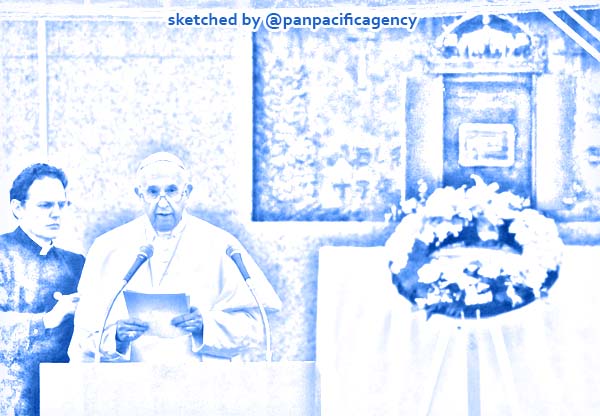Coronavirus pandemic stalling studies for a world without nuclear weapons in Hiroshima, Nagasaki

Pope Francis delivers a message at the Atomic Bomb Hypocenter Park, Nagasaki, on Nov. 24, 2019. Photo: Kyodo News. Sketched by the Pan Pacific Agency.
NAGASAKI, May 11, 2020, The Mainichi. The coronavirus pandemic is taking away opportunities for students to visit Hiroshima and Nagasaki to learn about the atomic bombings of the cities, and for survivors and activists to appeal for a world without nuclear weapons, The Mainichi reported.
A number of schools outside Hiroshima and Nagasaki prefectures in western Japan have postponed school trips there, and planned lectures by A-bomb survivors for visiting students have been cancelled. Those involved in these programs have voiced their concern, as this year marks the 75th anniversary of the U.S. atomic bombing of the two cities — an important opportunity to think about peace amid the declining number of A-bomb survivors still able to give testimonials.
Since 1979, there has been a sit-in in front of Nagasaki’s Peace Statue by anti-nuclear activists and “hibakusha” A-bomb survivors on the 9th of every month — the date a plutonium bomb was dropped on the city in August 1945. In normal times, the square in front of the statue is crowded with students on school excursions, foreign cruise ship passengers and other visitors, who would often stop and take photos of banners calling for nuclear weapons abolition.
However, after the spread of the coronavirus, just a few people pass by on the sit-in days.
“It’s abnormal. It’s not worth making appeals if no one is watching us,” lamented Koichi Kawano, 80, chairman of the A-bomb survivors’ liaison council of the Nagasaki Prefecture Peace Movement Center. But he added, “To gather here is the starting point for our anti-nuclear and peace drive. I’m not thinking about halting our sit-ins.”
The Nagasaki Atomic Bomb Museum, adjacent to the square, has extended its temporary closure until May 31 from May 6, after the central government extended the nationwide state of emergency over the coronavirus.
Testimonial activities by A-bomb survivors have also come to a standstill. The Nagasaki Foundation for the Promotion of Peace has decided to suspend their public lectures for visiting students and other groups until the end of July. This is because those lectures, conducted indoors, can create the “three Cs” (confined spaces, crowded places and close contact with others) conducive to infection transmission, raising concerns for the health of not only schoolchildren but also the elderly hibakusha.
As of May 7, the foundation had been notified of 248 cancellations and postponements of hibakusha lectures scheduled between late February and June. A total of some 26,000 people had been slated to attend the events.
“They were painful decisions, as A-bomb survivors want to convey their stories about the bombing,” said an official of the foundation in charge of the lectures.
In the city of Nagasaki, all municipal school students from the third grade through junior high are supposed to have attended A-bomb survivor lectures by Aug. 9. However, the program will be cancelled this year. Schools are planning to take alternative measures, such as showing videos of hibakusha sharing their bombing experiences.
The coronavirus crisis is also hindering peace studies in Hiroshima. While a record 1.76 million people visited the Hiroshima Peace Memorial Museum in fiscal 2019, the facility has been closed since Feb. 29 this year due to the coronavirus, and is not currently scheduled to reopen until May 17. To provide opportunities for people to consider nuclear arms issues, the museum has posted videos on its website of seven hibakusha recounting their experience of the nuclear attack on the city.
“The videos cannot replace words uttered in person by hibakusha, but we’d like at least to avoid seeing people’s interest in the issue decline,” said Katsunobu Hamaoka, vice director of the museum.
(Japanese original by Yuki Imano, Nagasaki Bureau)